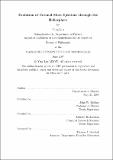| dc.contributor.advisor | John W. Belcher and John D. Richardson. | en_US |
| dc.contributor.author | Liu, Ying, Ph. D. Massachusetts Institute of Technology | en_US |
| dc.contributor.other | Massachusetts Institute of Technology. Dept. of Physics. | en_US |
| dc.date.accessioned | 2009-06-25T20:34:05Z | |
| dc.date.available | 2009-06-25T20:34:05Z | |
| dc.date.copyright | 2007 | en_US |
| dc.date.issued | 2007 | en_US |
| dc.identifier.uri | http://hdl.handle.net/1721.1/45608 | |
| dc.description | This electronic version was submitted by the student author. The certified thesis is available in the Institute Archives and Special Collections. | en_US |
| dc.description | Thesis (Ph. D.)--Massachusetts Institute of Technology, Dept. of Physics, 2007. | en_US |
| dc.description | Includes bibliographical references (p. 153-167). | en_US |
| dc.description.abstract | (cont.) These findings impose a serious problem on particle heating and acceleration within ICMEs. Both case studies and superposed epoch analysis demonstrate that plasma depletion layers (PDLs) and mirror-mode waves occur in the sheath regions of ICMEs with preceding shocks. A theoretical analysis shows that shock-induced temperature anisotropies can account for many observations made in interplanetary shocks, planetary bow shocks and the termination shock in the heliosphere. A comparative study of these shocks and corresponding sheaths reveals some universal processes, such as temperature anisotropy instabilities, magnetic field draping and plasma depletion. These results underscore important physical processes which alter the ICME environment. | en_US |
| dc.description.abstract | This thesis studies the evolution of coronal mass ejections (CMEs) in the solar wind. We develop a new method to determine the magnetic field orientation of CMEs using Faraday rotation. A radio source occulted by a moving magnetic flux rope gives two basic Faraday rotation curves, consistent with Helios observations. The axial component of the magnetic field produces a gradient in the Faraday rotation pattern obtained from multiple radio sources along the flux rope, which allows us to determine the CME field orientation and helicity 2 - 3 days before CMEs reach the Earth. We discuss implementation of the method by the Mileura Widefield Array. We present the first direct evidence that magnetic clouds (MCs) are highly flattened and curved due to their interaction with the ambient solar wind. The cross- sectional aspect ratio of MCs is estimated to be no smaller than 6 : 1. We offer a simple model to extract the radius of curvature of the cross section. Application of the model to observations shows that the cross section tends to be concave-outward at solar minimum while convex-outward near solar maximum. CMEs expand in the solar wind, but their temperature decreases more slowly with distance than an adiabatic profile. The turbulence dissipation rate, deduced from magnetic fluctuations within interplanetary CMEs (ICMEs), seems sufficient to produce the temperature profile. We find that the ICME plasma is collision dominated and the alpha-proton differential speed is quickly reduced. However, the alpha particles are preferentially heated with a temperature ratio Ta/Tp = 4 - 6. | en_US |
| dc.description.statementofresponsibility | by Ying Liu. | en_US |
| dc.format.extent | 167 p. | en_US |
| dc.language.iso | eng | en_US |
| dc.publisher | Massachusetts Institute of Technology | en_US |
| dc.rights | M.I.T. theses are protected by
copyright. They may be viewed from this source for any purpose, but
reproduction or distribution in any format is prohibited without written
permission. See provided URL for inquiries about permission. | en_US |
| dc.rights.uri | http://dspace.mit.edu/handle/1721.1/7582 | en_US |
| dc.subject | Physics. | en_US |
| dc.title | Evolution of coronal mass ejections through the heliosphere | en_US |
| dc.title.alternative | Evolution of CMEs through the heliosphere | en_US |
| dc.type | Thesis | en_US |
| dc.description.degree | Ph.D. | en_US |
| dc.contributor.department | Massachusetts Institute of Technology. Department of Physics | |
| dc.identifier.oclc | 319062234 | en_US |
